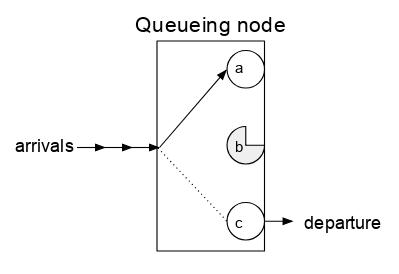Introduction
Therearealotoftangibleandintangiblequeuingorcrowdingphenomenaindailylife,suchasqueuesforticketpurchasesandbusylocaltelephonelines.Thebasicideaofqueuingtheorywasformedin1909byDanishmathematician,scientist,andengineerA.K.Erlangwhenhesolvedtheproblemofautomatictelephonedesign,whichwascalledthetraffictheoryatthattime.Inspiredbythethermodynamicsstatisticalbalancetheory,hesuccessfullyestablishedatelephonestatisticalbalancemodel,andderivedasetofrecursivestateequations,thusderivingthefamousErlangtelephonelossrateformula.
Sincethebeginningofthe20thcentury,telephonesystemdesignhasbeenapplyingthisformula.Inthe1930s,theSovietmathematicianA.Я.Xinchincalledthetelephonecallflowinstatisticalequilibriumthesimplestflow.SwedishmathematicianBalmintroducedconceptsanddefinitionssuchaslimitedaftereffectflow.Theyusedmathematicalmethodstoanalyzetheintrinsiccharacteristicsoftelephonecallsandpromotedthestudyofqueuingtheory.Intheearly1950s,Americanmathematicianresearchonbirthanddeathprocess,BritishmathematicianD.G.KendallputforwardtheembeddedMarkovchaintheory,andtheclassificationmethodofqueuingqueue,whichlaidthetheoreticalfoundationforqueuingtheory.Afterthis,L.Takakiandothersintroducedthecombinationmethodintoqueuingtheory,makingitmoresuitableforvarioustypesofqueuingproblems.Sincethe1970s,peoplehavebeguntostudyqueuingnetworksandtheasymptoticsolutionsofcomplexqueuingproblems,whichhavebecomeanewtrendinthestudyofmodernqueuingtheory.
Definition
queuingtheory,orstochasticservicesystemtheory,istoobtainthesequantitativeindicators(waitingtime,Queuelength,busyperiod,etc.),andthenimprovethestructureoftheservicesystemorreorganizetheserviceobjectsaccordingtotheselaws,sothattheservicesystemcannotonlymeettheneedsoftheserviceobjects,butalsomaketheorganization’sexpensesthemosteconomicalorSomeindicatorsareoptimal.Itisasub-disciplineofmathematicaloperationsresearchandadisciplinethatstudiestherandomlawofqueuingphenomenaintheservicesystem.Itiswidelyusedinarandomservicesystemforsharingvariousresourcessuchascomputernetworks,production,transportation,andinventory.Thecontentofqueuingtheoryresearchhasthreeaspects:statisticalinference,buildingmodelsbasedondata;systembehavior,thatis,theprobabilisticregularityofquantitativeindicatorsrelatedtoqueuing;systemoptimizationproblems.Itspurposeistocorrectlydesignandeffectivelyoperateeachservicesystemtomakeitplaythebestbenefit.
Thequeuingtheoryoriginatedfromtelephoneconversationsintheearly20thcentury.From1909to1920,theDanishmathematicianandelectricalengineerA.K.Erlangusedthemethodofprobabilitytheorytostudythetelephoneconversationproblem,thuscreatingthisappliedmathematicssubjectandestablishingmanybasicprinciplesforthissubject.Inthemid-1930s,whenW.Fellerintroducedthebirthanddeathprocess,queuingtheorywasrecognizedasanimportantsubjectinmathematics.DuringandafterWorldWarII,queuingtheorybecameanimportantcontentinthenewfieldofoperationsresearch.Intheearly1950s,D.G.Kendallmadeasystematicstudyofqueuingtheory.HeusedtheembeddedMarkovchainmethodtostudyqueuingtheory,whichledtofurtherdevelopmentofqueuingtheory.Itwashewhofirst(1951)usedthethree-lettersymbolX/Y/Ztorepresentaqueuingsystem.WhereXrepresentsthedistributionofcustomerarrivaltime,Yrepresentsthedistributionofservicetime,andZrepresentsthenumberofservicedesksintheserviceorganization.
1. Представяне на модел на опашка
X/Y/Z/A/B/C
X—клиентите пристигат един след другРазпределението на интервала от време;
Y—разпределението на времето за обслужване (M—експоненциално разпределение, D—определено време, Ek—k-разпределение на Erlang, G—общо разпределение и т.н.);
Z—брой сервизни гишета;
A—лимит на капацитета на системата(по подразбиране∞);
B—брой клиентски източници (по подразбиране∞);
C—Servicerule(thefaultisfirstcomefirstservedFCFS).
2.Индикатори за измерване на системата за опашка
Service CaptainLs—броят клиенти, които се обслужват;
Дължина на опашкаLq—броят клиенти, чакащи на опашката;
Обща дължина на опашката L=Ls+Lq—Общият брой клиенти в системата;
ServicetimeWs—Времето, изразходвано от клиентите в услугата;
Време на изчакване Wq—Времето, през което клиентът чака на опашката;

Общо времеW=Ws+Wq—Клиентът в систематаОбщото време на престой;
Busyperiod—thetimeintervalbetweentwoidletimesoftheserviceorganization;
Интензитет на услугатаρ;
Steadystate—thesystemrunsforalongenoughtimeAfterthat,theinfluenceoftheinitialstatebasicallydisappears,andthesystemstatenolongerchangeswithtime.
3,Съставът и перспективите за приложение на системата за опашка
Thequeuingsystemconsistsofinputprocessandarrivalrules,queuingrules,andserviceTheorganization'sstructure,servicehoursandserviceplanningcomposition.
Generally,itisalsoassumedthattheinter-arrivaltimesequenceandtheservicetimearebothindependentandidenticallydistributedrandomvariablesequences,andthesetwosequencesarealsoindependentofeachother.
Оценката на качеството на системата за опашка трябва да се основава на интересите както на клиента, така и на обслужващата организация. Що се отнася доклиентитевинаги се приема, чевремето за изчакванеиливремето за престойе възможно най-кратко, така че броят на гишетата за обслужване е възможно най-голям. Но що се отнася доорганизацията за обслужванезагрижен е, увеличаването на броя на сервизните станции означава увеличаване на инвестициите .Ако се увеличи, това ще доведе до разточителство. Ако се увеличи, това ще доведе до оплаквания на клиенти и дори до загуба на клиенти. Колко по-добре? За да се погрижат за собствените си интереси, клиентите и обслужващите организации трябва да се погрижат за трите индикатора в системата за чакане:капитан,време за изчакванеинатоварен период отот сервизното бюро((Отнесено към период на натовареност) са всички загрижени. Следователно , тези три индикатора се превърнаха в основното изследователско съдържание на теорията за опашките.
Theapplicationofqueuingtheoryisveryextensive.Itappliestoallservicesystems.Especiallyincommunicationsystems,transportationsystems,computers,storagesystems,productionmanagementsystems,etc.,itismostwidelyused.Theemergenceanddevelopmentofqueuingtheorycomesfromactualneeds,andactualneedswilldefinitelyaffectitsfuturedevelopmentdirection.
Components
Thequeuingsystemisalsocalledtheservicesystem.Theservicesystemiscomposedofserviceorganizationsandserviceobjects(customers).Thetimewhentheserviceobjectarrivesandthetimetoservehim(thatis,thetimeoccupiedbytheservicesystem)arerandom.Figure1showsthesimplestqueuingsystemmodel.Thequeuingsystemincludesthreecomponents:inputprocess,queuingrulesandserviceorganization.
Theinputprocess
Theinputprocessexaminesthelawofcustomersarrivingattheservicesystem.Itcanbedescribedbythenumberofcustomerarrivalswithinacertainperiodoftimeorthetimeintervalbetweensuccessivearrivalsoftwocustomers.Itisgenerallydividedintotwotypes:deterministicandrandom.Forexample,thepartsprocessedontheproductionlinearriveattheprocessinglocationinturnatthespecifiedintervaltime,andtheregularlyrunningshuttles,flights,etc.arealldeterministicinputs.Stochasticinputmeansthatthenumberofcustomerarrivalsn(t)withintimetobeysacertainrandomdistribution.IfitobeysthePoissondistribution,theprobabilityofreachingncustomerswithintimetis
или интервалът на времето на последователно пристигащи клиенти е с отрицателно експоненциално разпределение, а именно P(T≤t)=1–e-λt, където λ е очакването на броя на пристигащите клиенти за единица време, което се наричасреден процент на пристигане; 1/λ есредният интервал. теория ,обсъжданият процес на въвеждане е предимно произволен.
Правила за опашка
Правилата за опашка са разделени на система за чакане, система за загуба и смесена система. Когато клиентът пристигне, всички обслужващи организации са заети и клиентът чака на линия, което есистемата за чакане. В системата за чакане редът на обслужване за клиентите може да бъде първи дошъл, първи обслужен, или st-come-first served,orrandomserviceandpriorityservice (като болници, приемащи спешни пациенти). Ако клиентът пристигне и види, че обслужващата организация не е свободна да си тръгне незабавно, това есистема за загуба. Някои системи имат ограничено пространство за клиенти да чакат на опашка, така че клиентите, които надхвърлят капацитета, трябва да напуснат системата. Това правило за чакане есмесена система.
Организация на обслужване
Може да бъде едно или повече сервизни бюра. Множество сервизни бюра могат да бъдат подредени в паралелна или серия. Времето за обслужване обикновено се разделя на два типа: детерминистично и произволно. Например, устройство, което автоматично промива кола, има едно и също време за промиване (обслужване) за всяка кола, така че е детерминирано. fito е отрицателното експоненциално разпределение, функцията на разпределение е P(v≤t)=1–e-μt, където μ есредната тарифа за обслужванеи 1/μ еСредно време за обслужване.
Problemsolving
Themainpurposeofstudyingthequeuingsystemproblemistostudyitsoperatingefficiencyandassessthequalityofservice,sothatimprovementmeasurescanbeproposedaccordingly.Thereareusually6quantitativeindicatorsforevaluatingtheprosandconsofaqueuingsystem:
①Systemloadlevelρ:Itisameasureoftheservicedesk'sabilitytoundertakeservicesandmeetneeds;
②SystemIdleprobabilityP0:Системата е с вероятност клиентите да не идват да искат услуга;
③Капитан: Общият брой клиенти, чакащи на опашка за обслужване и обслужвани в системата, средната стойност се записва Е Ls;
④Капитан: броят клиенти, чакащи на опашка в системата, средната стойност се записва като Lg;
⑤Време на престой: времето, през което клиентът остава в системата, включително времето за изчакване и времето за обслужване, средната стойност се записва като Ws;
⑥Waitingtime:acustomerstaysinthesystemTheaveragewaitingtimeinthesystemisrecordedasWg.TheM/M/1queuingsystemisthesimplestqueuingsystem.ThevariousindicatorsofthesystemcanbecalculatedfromthestatetransitionspeeddiagramoftheMarkovchaininthefollowingfigure(Table1).Thecalculationformulasforvariousindicatorsofothertypesofqueuingsystemsaremuchmorecomplicated,andthecalculationformulachartscanbespecificallylistedforreference.Computersimulationhasbeenappliedtosolvetheproblemofqueuingsystem.
Приложение
Теорията на опашките е широко използвана в транспортни системи, проектиране на пристанищни пристанища, поддръжка на машини, контрол на инвентара и други системи за обслужване. Таблица 2 изброява приложенията на теорията на опашките.
